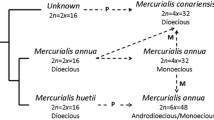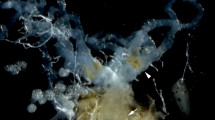Abstract
Sex mosaicism, also called gynandromorphism, refers to an accidental phenomenon in dioecious organisms (mainly animals) in which an individual phenotype includes both female and male characteristics. Despite the rarity of this phenomenon, elucidating the mechanisms of naturally occurring sex mosaicism should deepen our understanding of diverse sex determination and differentiation systems in nature. We report the results of a genetic study of a sex mosaic individual of the ant Diacamma sp. from Japan’s Okinawa Island. Parentage analysis using microsatellite markers revealed that the female and male parts of the sex mosaic showed different inheritance patterns: female parts had alleles consistent with their biparental inheritance, whereas most of the male parts had alleles consistent with their paternal inheritance (i.e., androgenesis). We discuss plausible cytogenetic mechanisms that gave rise to the male parts of this individual: polyspermy and the subsequent independent cleavage by a surplus sperm pronucleus, and maternal genome elimination after fertilization of an ovule. Moreover, we hypothesize that the androgenetically produced males found in some Hymenoptera might share the same underlying cytogenetic mechanism with hymenopteran sex mosaicism.


Similar content being viewed by others
References
Berndt K.P. and Kremer G. 1982. Heat shock-induced gynandromorphism in the pharaoh’s ant, Monomorium pharaonis (L.). Cell. Mol. Life Sci. 38: 798-799
Birkhead T.R., Hosken D.J. and Pitnick S. 2009. Sperm Biology: An Evolutionary Perspective. Academic Press, London
Clark A.M., Gould A.B. and Potts M.F. 1968. Mosaicism in Habrobracon juglandis associated with the ebony locus. Genetics 58: 415-422
Doums C. 1999. Characterization of microsatellite loci in the queenless Ponerine ant Diacamma cyaneiventre. Mol. Ecol. 8: 1957-1959
Foucaud J., Fournier D., Orivel J. et al. 2007. Sex and clonality in the little fire ant. Mol. Biol. Evol. 24: 2465-2473
Foucaud J., Estoup A., Loiseau A. et al. 2010. Thelytokous parthenogenesis, male clonality and genetic caste determination in the little fire ant: new evidence and insights from the lab. Heredity 105: 205-212
Fournier D., Estoup A., Orivel J. et al. 2005. Clonal reproduction by males and females in the little fire ant. Nature 435: 1230-1234
Fukumoto Y., Abe T. and Taki A. 1989. A novel form of colony organization in the “queenless” ant Diacamma rugosum. Physiol. Ecol. Jpn 26: 55-61
Kinomura K. and Yamauchi K. 1994. Frequent occurrence of gynandromorphs in the natural population of the ant Vollenhovia emeryi (Hymenoptera: Formicidae). Insect. Soc. 41: 273-278
Koeniger N., Hemmling C. and Yoshida T. 1989. Drones as sons of drones in Apis mellifera. Apidologie 20: 391-394
Moilanen A., Sundström L. and Pedersen J.S. 2004. MATESOFT: a program for deducing parental genotypes and estimating mating system statistics in haplodiploid species. Mol. Ecol. Notes 4: 795-797
Morgan T.H. 1905. An alternative interpretation of the origin of gynandromorphous insects. Science 21: 632-634
Nachtsheim H. 1913. Cytologische Studien über die Geschlechtsbestimmung bei der Honigbiene (Apis mellifera L.). Arch. Zellforsch. 11: 169-239
Nakata K., Tsuji K., Hölldobler B. and Taki A. 1998. Sexual calling by workers using the metatibial glands in the ant, Diacamma sp. J. Insect Behav. 11: 869-877
Nilsson G.E. 1987. A gynandromorphic specimen of Evylaeus albipes (Fabricius) (Hymenoptera, Halictidae) and a discussion of possible causes of gynandromorphism in haplo-diploid insects. Not. Ent. 67: 157-162
Ohkawara K., Nakayama M., Satoh A. et al. 2006. Clonal reproduction and genetic caste differences in a queen-polymorphic ant, Vollenhovia emeryi. Biol. Lett. 2: 359-363
Okada Y., Miyazaki S., Koshikawa S. et al. 2010. Identification of a reproductive-specific, putative lipid transport protein gene in a queenless ponerine ant. Naturwissenschaften 97: 971-979
Pearcy M., Goodisman M.A.D. and Keller L. 2011. Sib mating without inbreeding in the longhorn crazy ant. Proc. R. Soc. Lond. B. doi:10.1098/rspb.2010.2562
Queller D. 2005. Evolutionary biology: Males from Mars. Nature 435: 1167-1168
Raymond M. and Rousset F. 1995. GENEPOP (version 1.2): a population genetics software for exact tests and ecumenicism. J. Hered. 86: 248-249
Rothenbuhler W.C., Gowen J.W.and Park O.W. 1952. Androgenesis with zygogenesis in gynandromorphic honeybees (Apis mellifera L.). Science 115: 637-638
Speitcher B.R. 1936. Oogenesis, fertilization and early cleavage in Habrobracon. J. Morphol. 59: 401-421
Takahashi J., Kikuchi T., Ohnishi H. and Tsuji K. 2005. Isolation and characterization of 10 microsatellite loci in the Ponerinae ant Pachycondyla luteipes (Hymenoptera; Formicidae). Mol. Ecol. Notes 5: 749-751
Viginier B., Peeters C., Brazier L. and Doums C. 2004. Very low genetic variability in the Indian queenless ant Diacamma indicum. Mol. Ecol. 13: 2095-2100
Walsh P.S., Metzger D.A. and Higuchi R. 1991. Chelex 100 as a medium for simple extraction of DNA for PCR-based typing from forensic material. BioTechniques 10: 506-513
Yang A.S. and Abouheif E. 2011. Gynandromorphs as indicators of modularity and evolvability in ants. J. Exp. Zool. B Mol. Dev. Evol. 316B: 313-318
Yoshizawa J., Mimori K., Yamauchi K. and Tsuchida K. 2009. Sex mosaics in a male dimorphic ant Cardiocondyla kagutsuchi. Naturwissenschaften 96: 49-55
Acknowledgments
We thank T. Akino and R. Yasudai for assistance in the field survey and M. Okamoto and A. Mikheyev for discussions. We also thank the editor and two anonymous referees for their constructive comments. SD was supported by Research Fellowship from the Japan Society for the Promotion of Science for Young Scientists (22-9877).
Author information
Authors and Affiliations
Corresponding authors
Additional information
S. Dobata and H. Shimoji contributed equally to this work.
Electronic supplementary material
Below is the link to the electronic supplementary material.
Supplementary material 1 (MPG 1743 kb)
Rights and permissions
About this article
Cite this article
Dobata, S., Shimoji, H., Ohnishi, H. et al. Paternally inherited alleles in male body parts of an ant (Diacamma sp.) sex mosaic: implication for androgenetic male production in the Hymenoptera. Insect. Soc. 59, 55–59 (2012). https://doi.org/10.1007/s00040-011-0187-5
Received:
Revised:
Accepted:
Published:
Issue Date:
DOI: https://doi.org/10.1007/s00040-011-0187-5




